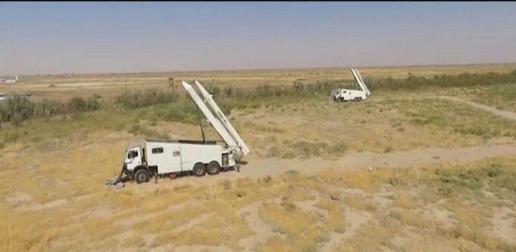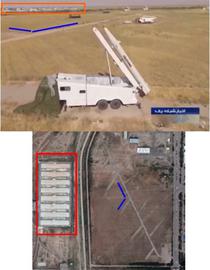On Saturday September 8, just hours after the execution of three Kurds on charges of working with armed secessionist groups, Iran’s Revolutionary Guards fired missiles on the Iraq-based Democratic Party of Iranian Kurdistan (PDKI) in the city of Koy Sanjaq in northern Iraq. The Aerospace Force of the Islamic Revolutionary Guard Corps (IRGC) carried out the attack, supported by the Guards’ Ground Forces Drone Unit (see video).
According to a statement issued by the PDKI, 15 Kurdish politicians and civilians were killed and 50 others were injured during the attack, which took place during a meeting between the leaders of both the PDKI and the Kurdistan Democratic Party (KDP), a breakaway branch of the PDKI. Mustafa Mauludi, secretary-general of the KDP, suffered superficial injuries but survived the attack.
According to witnesses, between 10 and 12 surface-to-surface missiles were fired from Iran at Koy Sanjaq, but some of them missed their targets by more than 700 meters. On Sunday, September 9, the Revolutionary Guards confirmed the attack, but put the number of missiles at seven [Persian link], despite the fact that Mashregh News, a website close to the Guards, had reported the number to be five.
Videos of missile launch posted on social media indicate that at least a majority of them were launched from the Al-Mahdi Base outside Urmia, the capital of West Azerbaijan. The footage also shows that missiles were dispatched from three launchers, each of which were capable of firing multiple missiles.
Photographs published by the IRGC itself show that several Fateh-110 missiles were also launched from the Seyed al-Shohada Training Center, close to the city of Azar Shahr in the province of West Azerbaijan. Serial numbers beginning with the letters “FB” are visible in the photographs, indicating that the missiles belonged to the second generation of Fateh-110 missiles that were unveiled in 2005. So far, the IRGC has unveiled four generations of the Fateh-110 missile. In 2014, Hassan Nasrallah, Secretary General of the Lebanese Hezbollah, said his forces have been in possession of Fateh-110 missiles since 2006.
Fateh has been described as the Guards’ most accurate missile and, according IRGC-affiliated media, the Zolfaghar missiles that IRGC forces used in a June 18, 2017 attack on ISIS positions in Syria are a “new generation” of Fateh missiles.
A Question of Accuracy
Despite being touted as the Guards’ “most accurate” missiles, photographs of Koy Sanjaq after the attack posted on Kurdish media show that only one missile struck the headquarters of the Democratic Party of Iranian Kurdistan. The missile collided with the top of the building and exploded in the headquarters’ courtyard. These short-range surface-to-surface missiles carry 200 to 500 kilos of explosives and, as a result, the strike brought down the courtyard’s wall and caused fatalities and injuries.
Pictures from IRGC drones over the target show two explosions at the PDKI’s headquarters but, considering that the building is an old army garrison from Saddam Hussein’s days, it is possible that explosives remaining in the barracks were set off by the missile’s primary explosion. In any case, it is not clear whether this missile or missiles were launched from Azar Shahr or from Urmia.
Even if, on the basis of photographs of the targets transmitted by the drones, it can be assumed that two missiles did in fact hit the PDKI’s headquarters, the operation still amounts to a demerit for the Guards. Civilians posted videos showing that at least 10 missiles had been launched from Urmia, and the IRGC says that seven were launched from Azar Shahr. If out of 17 missiles only two hit their target, then the rate of success for the Guards’ attack was a little over 10 percent.
In the 2017 attack on ISIS positions in Syria, two out of 17, or 27 percent, hit their targets. But despite the casualties inflicted in the September 8 attack, high commanders and the top leaders of the two Kurdish parties survived and the headquarters itself is not severely damaged. From this viewpoint, the missile attack was not very successful either, despite the fact that since the Guards confirmed the attack, pro-Guards media have done what they can to convince the public that it was an unquestionable success.
The Guards' Know Flaws Exist
But from a technical point of view, and by looking at the photographs that the Revolutionary Guards published of Fateh missiles launched from Azar Shahr, one can speculate that the IRGC is aware of the inaccuracy of the Fateh missile — and so at the same time launched other types of missiles from Urmia.
Koy Sanjaq is located 180 kilometers from Urmia and 230 kilometers from Azar Shahr. Fateh-110 missiles launched from Azar Shahr have a maximum range of 300 kilometers. In its missile operation launched from Urmia, which is closer to Koy Sanjaq, the IRGC could have used Fateh, Zolfaghar and/or Raad-307 missiles, which have enough range to hit targets 180 kilometers away. But since the photographs show that missile launchers had been used at Urmia’s base, this means these missiles could not have been used in the operation.
The only multiple-missile launchers the Guards Corps has are Chinese Weishi rocket launchers. WS-2/3 rockets, which China exports under the names A-200 and A-300, have ranges from between 200 and 300 kilometers and are equipped with course-correction systems to increase their accuracy.
This is not the first time that the Guards have been suspected of using Weishi missile and rocket systems. In 2014, when the Israeli navy intercepted and boarded a vessel in the Red Sea, it found 1,000 surface-to-surface rockets from the WS-1 family. UN experts later concluded that the cargo had been on its way from Iran to Gaza.
Various Kurdish groups may choose to retaliate against the Guards’ missile attack on the PDKI’s headquarters and the resulting civilian casualties in Koy Sanjaq. This has the potential to engulf northwestern Iran in a new wave of violence. At the same time, the missiles’ weak performance during the attack on Iraqi Kurdistan can hurt the IRGC in different ways. At the very least, it creates serious doubts about the missile might of the Guards and its capacity to launch accurate attacks at targets outside the borders of Iran. It also calls into question whether hostile governments will regard the missile program as a powerful enough deterrent against entering into conflict with the Islamic Republic.
More on the Revolutionary Guards’ Missile Program:
Guards Sell Missile Program to the Iranian Public, June 22, 2018
Guards to Protect Iran's Missiles from Cyberwarfare, April 12, 2018
Iran Caught in “Missile Trap” After UN Report, January 15, 2018
Iran's Missile Program: In the Footsteps of Saddam Hussein, November 16, 2017
Iranian Missiles Target Israel...and Rouhani’s Trade Deals, March 9, 2016
Of Missiles and Morals, April 22, 2016
visit the accountability section
In this section of Iran Wire, you can contact the officials and launch your campaign for various problems



























comments